http://e-info.org.tw/node/117977
烏干達農民的希望 非基改「氣候適應豆」出爐
文字大小
138 1 Share1
本報2016年8月26日綜合外電報導,蔡宜臻編譯;蔡麗伶審校
乾旱和高溫衝擊著烏干達的收成,但新型的「氣候適應」豆子,或許可以幫助當地穩定食物供應,並改善兒童微量營養素營養不良的問題。
「氣候適應」豆或許能讓烏干達農民撐過乾旱。圖片來源:Georgina Smith / CIAT(CC BY-NC-SA 2.0)。
高營養抗旱豆子 烏干達農夫生存希望
科學家研發出五種新型生物強化品種,藉由選擇性育種的自然過程,富含豐富的鐵和鋅,更是市場上比傳統品種更有效抗旱的品種。
在烏干達,1800萬農夫中有超過85%生產豆類,其中有40%的相關產品是由貧窮人口購買。足以抵禦氣候變遷的主食,也就能幫助當地農村人口保住性命。
乾旱現象肆虐著東非,經過極端又漫長的聖嬰現象後,有研究員擔心迅速演變成反聖嬰現象,對這些地區將是噩耗,因為在歷史上,反聖嬰現象往往與嚴重乾旱有關。在不確定的情況下,選擇不遷移的農民,只能嘗試盡快適應,以免對生計造成影響。
新品種的豆子是度過乾旱期的最佳解方,因為成熟時間較快,需要的雨水量也較少,能夠在乾旱期逃過一劫。
新品種豆子在溫度升高時的反應較佳,農夫能夠在低海拔地區種植,無需遷移到較高海拔,溫度較低的的地點。
除了較健康,新型豆子也有經濟效益。圖片來源:Georgina Smith / CIAT(CC BY-NC-SA 2.0)。
豆子富含鐵、鋅 改善營養不良問題
「我們了解到,由於在烏干達豆類飲食的重要性,在其營養特性上的任何變化,都會對消費者有很大的影響。」烏干達國家作物資源研究所主管Stanley Nkalubo解釋。
調查發現,因為營養不良的關係,烏干達五歲以下的兒童中有接近38%不達應有年紀的身高,16%過瘦。
研究顯示,健康的飲食不只是足夠的熱量攝取。吸收微量營養素如礦物質和維生素,更是至關重要。隨著氣候變遷奪走越來越多的肥沃土地,隱性飢餓的問題可能於東非及以外的地區失控。
「微量營養素營養不良,即所謂的「隱性飢餓」,影響超過一半的世界人口,特別是在發展中國家的婦女和學齡前兒童。」參與研究的泛非豆類研究聯盟培育員Clare Mukankusi表示。
新型豆子是與農夫合作開發出來的。圖片來源:Georgina Smith / CIAT(CC BY-NC-SA 2.0)。
以與傳統豆子相同的價格進入市場,新型的「氣候適應豆」除了較健康,也有經濟效益。
「因為農民不需要額外購買營養補充品,只需種植新豆,因此改良品種也是一項很好的投資。」Nkalubo說明。
在旱季,新型豆子還是具有產量保證,並能改善極端氣候之下的家庭生產力,形成有益的投資。再加上,豆子是與農夫合作開發出來的,科學家與農夫們一同評估適合的顏色,味道,烹調時間和耐受性條件如害蟲或土壤貧脊。而13種研發出來的新豆子中,只有最好的五種實地投入種植。
烏干達的試驗,僅僅是讓東非朝著建立糧食安全和復原能力的第一步。
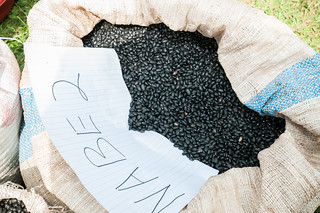 | 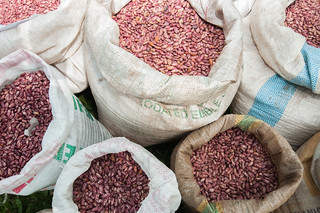 |
| 新型豆子的價格與傳統豆子不相上下。圖片來源:Georgina Smith / CIAT(CC BY-NC-SA 2.0)。 | 有了新型豆子,農民就不用再購買營養補充品了。圖片來源:Georgina Smith / CIAT(CC BY-NC-SA 2.0)。 |
去年同樣因聖嬰現象而受饑荒之苦的非洲國家,包括肯亞,坦尚尼亞,馬達加斯加,剛果民主共和國,以及衣索比亞,如今也收到育種的素材。
不過,由於每個國家都有其獨特的生態系統,因此在現場測試之前,會依種子的特性以及農民的偏好,並遵循特定的管道後,才會使用。
不同於烏干達,蒲隆地已經釋出三個新品種。接來來幾個月,農夫將審視這些「氣候適應」豆子,是否達到期望,並評估對於營養不良問題,是否能夠帶來的直接影響。
Climate-smart beans offer hope to Uganda’s farmers
Drought and heat have hit Ugandan harvests, but new varieties of seeds and beans could help secure food supplies in vulnerable regions

15 varieties of seeds have been introduced to farmers in Hoima, north-western Uganda (Pic: Georgina Smith / CIAT)
Farmers in Uganda can now add a new climate-smart bean to their toolbox to respond to an increasingly hot climate and rife malnutrition.
Scientists have developed five new ‘biofortified’ varieties, enriched with iron and zinc through a natural process of selective breeding, which are able to withstand drought more effectively than conventional breeds currently on the market.
In a country where beans provide 40% of the proteins consumed by the poor and are grown by over 85% of the 18 million farmers, climate-proofing their main staple could be a life-saver for the rural population of Uganda.
Drought is currently ravaging East Africa, after an exceptionally intense and long El Niño which some observers are afraid will rapidly morph into La Niña.
This would be very bad news for the region, as La Niña is historically associated with severe drought.
In a scenario of such uncertainty, farmers who chose not to migrate can only try to adapt as fast as possible to avoid the worst impacts on their livelihoods.
The new beans could be a key factor in riding out the drought. Because their plants mature faster and need a lower amount of rain, they escape the worst impacts of dry spells.
They also respond better to increased temperatures, allowing farmers to keep their plantations at a lower level without moving to higher ground, where the weather is cooler.

New bean varieties each have different qualities: drought resilience; disease tolerance; high iron (Pic: CIAT/Flickr)
“We realised that because of the importance of beans in Ugandan diet, any change in their nutritional properties would have a big impact on the consumer,” said Stanley Nkalubo, programme leader at the National Crops Resources Research Institute, who took care of the breeding process and the dissemination of the seedlings.
A survey revealed that in Uganda nearly 38% of children below the age of five are short for their age and 16% are underweight as a result of malnutrition.
And research today shows that a healthy diet is not just about the amount of calories eaten, but micro-nutrients such as minerals and vitamins absorbed are as much as if not more important.
The new climate smart beans are hitting the market at the same price of their conventional counterparts, but other than being healthier they also have economic benefits.
“Because the farmers won’t have to buy supplements, but just grow their new beans, the improved breeds are also a good investment” said Nkalubo.
What also makes for good return on investment is the capacity of the plants to guarantee yields even in case of drought, improving households’ resilience in the face of extremes.
The beans were developed in cooperation with the farmers who assessed the new varieties for preferred color, taste, cooking time and tolerance to factors such as pests or impoverished soil. Of the 13 breeds developed, only the best five made it to the field.
‘Micronutrient malnutrition, the so-called “hidden hunger”, affects more than half of the world’s population, especially women and preschool children in developing countries,’ said Clare Mukankusi, a breeder with the Pan-African Bean Research Alliance, which was also involved in the project.
With climate change claiming more and more fertile land, hidden hunger could spiral out of control in East Africa and beyond.
The Ugandan experiment is only the first step towards building food security and resilience all over East Africa.
Mukankusi explained that other countries have received the materials, including Kenya, Tanzania, Madagascar, DRC and Ethiopia, where last year’s El Niño has left a trail of famine and destruction.
But because each country has its own unique ecosystem, the seedlings that are field tested need to follow a particular pipeline before being released, depending on their performance and farmers’ preference.
Other than Uganda, Burundi has also already released three of the new breeds, and over the coming months farmers will judge if the new climate-smart beans live up to their promises, and estimate the direct effect they can have on malnutrition.
Lou Del Bello’s series of reports on Africa and climate change is funded by CDKN.
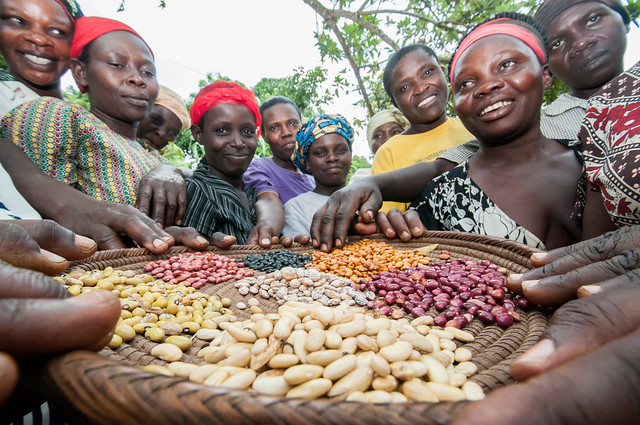
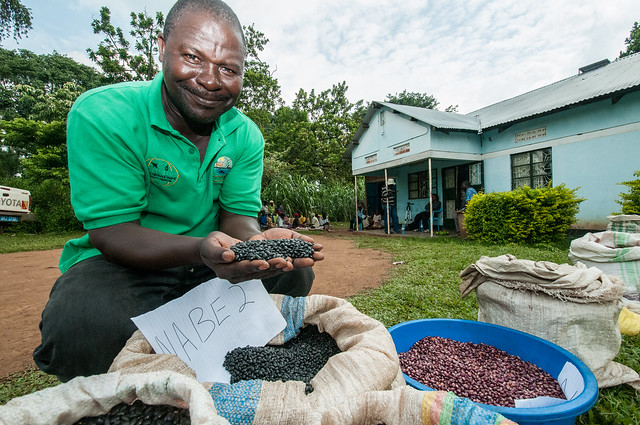
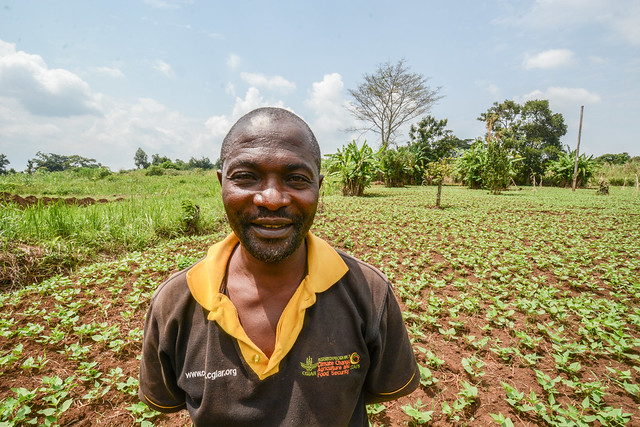








沒有留言:
張貼留言